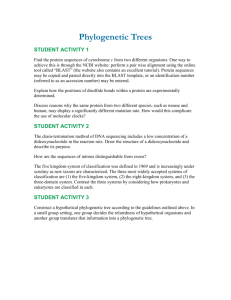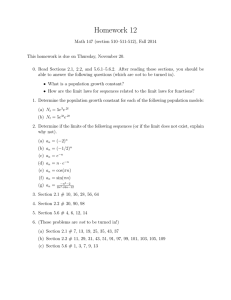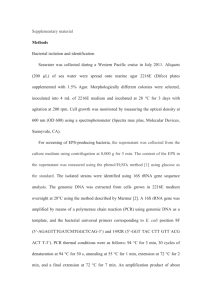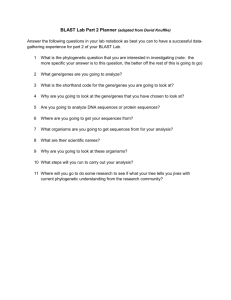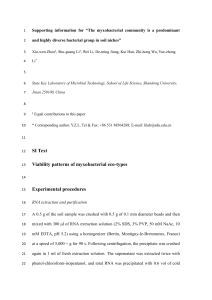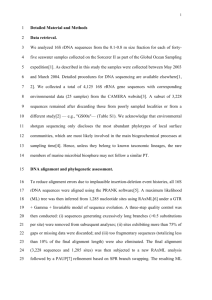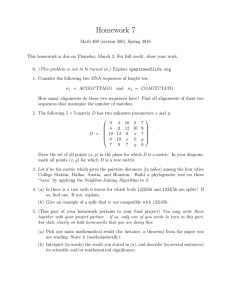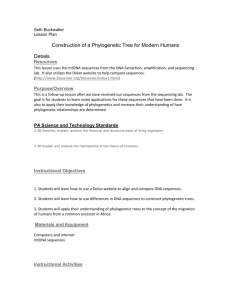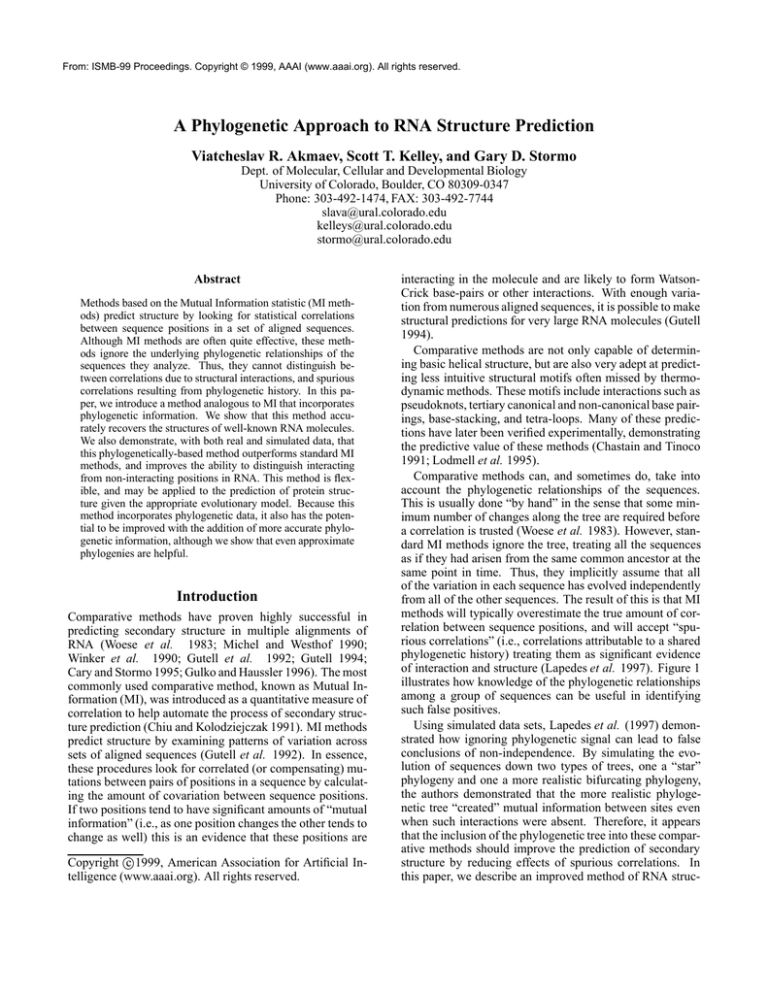
From: ISMB-99 Proceedings. Copyright © 1999, AAAI (www.aaai.org). All rights reserved.
A Phylogenetic Approach to RNA Structure Prediction
Viatcheslav R. Akmaev, Scott T. Kelley, and Gary D. Stormo
Dept. of Molecular, Cellular and Developmental Biology
University of Colorado, Boulder, CO 80309-0347
Phone: 303-492-1474, FAX: 303-492-7744
slava@ural.colorado.edu
kelleys@ural.colorado.edu
stormo@ural.colorado.edu
Abstract
Methods based on the Mutual Information statistic (MI methods) predict structure by looking for statistical correlations
between sequence positions in a set of aligned sequences.
Although MI methods are often quite effective, these methods ignore the underlying phylogenetic relationships of the
sequences they analyze. Thus, they cannot distinguish between correlations due to structural interactions, and spurious
correlations resulting from phylogenetic history. In this paper, we introduce a method analogous to MI that incorporates
phylogenetic information. We show that this method accurately recovers the structures of well-known RNA molecules.
We also demonstrate, with both real and simulated data, that
this phylogenetically-based method outperforms standard MI
methods, and improves the ability to distinguish interacting
from non-interacting positions in RNA. This method is flexible, and may be applied to the prediction of protein structure given the appropriate evolutionary model. Because this
method incorporates phylogenetic data, it also has the potential to be improved with the addition of more accurate phylogenetic information, although we show that even approximate
phylogenies are helpful.
Introduction
Comparative methods have proven highly successful in
predicting secondary structure in multiple alignments of
RNA (Woese et al. 1983; Michel and Westhof 1990;
Winker et al. 1990; Gutell et al. 1992; Gutell 1994;
Cary and Stormo 1995; Gulko and Haussler 1996). The most
commonly used comparative method, known as Mutual Information (MI), was introduced as a quantitative measure of
correlation to help automate the process of secondary structure prediction (Chiu and Kolodziejczak 1991). MI methods
predict structure by examining patterns of variation across
sets of aligned sequences (Gutell et al. 1992). In essence,
these procedures look for correlated (or compensating) mutations between pairs of positions in a sequence by calculating the amount of covariation between sequence positions.
If two positions tend to have significant amounts of “mutual
information” (i.e., as one position changes the other tends to
change as well) this is an evidence that these positions are
c 1999, American Association for Artificial InCopyright telligence (www.aaai.org). All rights reserved.
interacting in the molecule and are likely to form WatsonCrick base-pairs or other interactions. With enough variation from numerous aligned sequences, it is possible to make
structural predictions for very large RNA molecules (Gutell
1994).
Comparative methods are not only capable of determining basic helical structure, but are also very adept at predicting less intuitive structural motifs often missed by thermodynamic methods. These motifs include interactions such as
pseudoknots, tertiary canonical and non-canonical base pairings, base-stacking, and tetra-loops. Many of these predictions have later been verified experimentally, demonstrating
the predictive value of these methods (Chastain and Tinoco
1991; Lodmell et al. 1995).
Comparative methods can, and sometimes do, take into
account the phylogenetic relationships of the sequences.
This is usually done “by hand” in the sense that some minimum number of changes along the tree are required before
a correlation is trusted (Woese et al. 1983). However, standard MI methods ignore the tree, treating all the sequences
as if they had arisen from the same common ancestor at the
same point in time. Thus, they implicitly assume that all
of the variation in each sequence has evolved independently
from all of the other sequences. The result of this is that MI
methods will typically overestimate the true amount of correlation between sequence positions, and will accept “spurious correlations” (i.e., correlations attributable to a shared
phylogenetic history) treating them as significant evidence
of interaction and structure (Lapedes et al. 1997). Figure 1
illustrates how knowledge of the phylogenetic relationships
among a group of sequences can be useful in identifying
such false positives.
Using simulated data sets, Lapedes et al. (1997) demonstrated how ignoring phylogenetic signal can lead to false
conclusions of non-independence. By simulating the evolution of sequences down two types of trees, one a “star”
phylogeny and one a more realistic bifurcating phylogeny,
the authors demonstrated that the more realistic phylogenetic tree “created” mutual information between sites even
when such interactions were absent. Therefore, it appears
that the inclusion of the phylogenetic tree into these comparative methods should improve the prediction of secondary
structure by reducing effects of spurious correlations. In
this paper, we describe an improved method of RNA struc-
Figure 1: A hypothetical example showing covariation between positions in an RNA sequence. The figure shows a set
of aligned homologous sequences. Using standard mutual
information methods, in the absence of a phylogeny, positions 2 and 6 would appear to covary as would positions 8
and 10. In other words, each time there is a change in one
position, there is a corresponding change in the other. However, the phylogeny on the right indicates that sequences 1-3
form a closely related group, as do sequences 4-6. If the
common ancestor of all these sequences had a G at position
2 and a C at position 6, there would only be evidence for
one independent origin of compensating mutations between
these positions (indicated by the arrow). On the other hand,
there are multiple instances of correlated mutations between
positions 8 and 10 because related taxa are all dissimilar at
these two positions indicating multiple independent origins
of this correlation.
ture prediction analogous to mutual information techniques
that incorporates phylogenetic information. By taking the
tree into account, we show that the method reduces the number of false positives detected by non-phylogenetic methods,
and increases the ability to detect truly correlated positions.
Phylogenetically Based Structure Prediction
In our approach to the correlation analysis of RNA sequences, we first estimate the independent rates of evolution for each position in the sequence along a phylogenetic
tree. In particular, we apply the Hasegawa-Kishino-Yano
(HKY85) (Hasegawa et al. 1985) model of DNA/RNA sequence evolution down a given tree for each site of the sequences. A number of DNA/RNA sequence evolution models have been developed during the last twenty years (reviewed by Swofford 1998). The well-known Jukes-Cantor
model (Jukes and Cantor 1969) is the simplest of these,
while the GTR, general time-reversible 11-parameter model
is probably the most complex generalization that has been
considered (Lanave et al. 1984). Surprisingly, the assumption of the same substitution rates over the sites of the sequences was a very common one in the past, presumably because this was less computationally demanding. However,
with constantly increasing computational power, the opportunity to work with more general (i.e., more realistic) models becomes very attractive. We settled on the 6 parameter
HKY85 model as a compromise between model complexity
and computational efficiency.
The HKY85 model has six unknown parameters: the four
nucleotides equilibrium frequencies, the mean substitution
rate and the transition-transversion ratio. However, only
five of these six parameters are independent because the nucleotide frequencies add up to one. The question is how do
we find the parameters of the model given a data set and a
phylogeny estimate? Basically, the estimates of the parameters are the set of numbers that maximizes the likelihood
function of the data given a set of aligned sequences and a
phylogenetic tree. The numerical aspects of the maximization problem have been addressed in previous works (Schadt
et al. 1998). The output is the optimal parameters of the
HKY85 model and the maximum of the likelihood function
for each position of the sequences. Because we optimize the
parameters of the model separately for each position we are
probably over-fitting to the data, especially when we have
a small number of sequences. But because our use of these
parameters is to identify pairs of positions that do not appear
to evolve independently, the result is that our identification
of correlated positions is conservative.
Given the rate parameters at each site, assuming that each
position evolved independently of all others, the next step
is to determine if two positions evolved independently or if
they show some bias towards simultaneous mutations on the
phylogenetic tree. Recently, efforts have been made to simplify the joint distribution approach to some kind of quasijoint evolution models with some positive results, though
the method clearly needs refining (Muse 1995). Some methods even try to work out the real joint distribution model for
a pair of positions (Gulko and Haussler 1996). Gulko and
Haussler’s results were very impressive. However, in our
approach we do not make many of the simplifications that
they used (e.g., the discrete branch lengths, the same rates
of evolution at all positions of a multiple alignment as well
as the high dependence of the result on the training dataset,
and the requirement of a training dataset itself).
Certainly, the ideal approach would be to determine the
optimal evolution parameters for each potential pair of interacting positions, and then choose the “good ones” based on
how much better they fit the data. However, this is impractical on many datasets for two reasons. First, the number of
parameters for joint evolution is larger; how large depends
on the model used to describe evolution of pairs. Second,
and more important, is the great number of potential pairs
one has to examine to identify the set of true pairs. For example, in a sequence of length 1000, there are at most 500
pairs of interacting positions. (This assumes each base interacts with at most one other position. While this ignores
base-triple interactions, it is a reasonable limit to the expected number of interactions in RNA.) But the total number
of pair-wise combinations is about 500,000. Determining
the maximum likelihood parameters for all of those potential pairs, in order to find out which pairs are not well described by independent evolution, would be prohibitive. Our
approach is much faster and can identify the likely interacting positions, including information from the phylogenetic
tree, which can then be examined in more detail.
In this paper, we describe a statistical estimation method
of structure prediction that combines a phylogenetic approach, utilizing the HKY85 model, with a purely statistical approach that does not take into account the phylogeny.
The likelihood ratio of these two approaches essentially asks
whether the evolution of two positions is better described by
a model that takes the tree into account, but assumes inde-
pendence, or a model that ignores the tree but assumes interactions. We show that this method is a more reliable predictor of interacting positions, on both real and simulated
datasets, than standard MI-based methods. We demonstrate
its use on three example datasets.
Materials and Methods
Data Sets
Sequence alignments of tRNA’s and 16S small subunit
rRNA’s were obtained by downloading from the world wide
web (tRNA: (Sprinzl et al. 1998) 16S rRNA: (Van de Peer et
al. 1998)). For the analysis of tRNA sequences, we used 300
sequences representing a diverse array of taxa. For the analysis of 16S rRNA, we selected approximately 150 bacterial
sequences from 12 bacterial families. The 16S sequences
were selected such that the phylogeny of these sequences
would resemble the tree of Figure 5B. In other words, we
selected groups of closely related sequences from among
several distantly related bacterial families.
For the 16S rRNA sequences, we used the alignments
as they were presented in the web sites (as we did for the
tRNA sequences) except that we removed positions in the
16S bacterial sequence alignments at which 20% or more of
the sequences contained gaps. This was necessary because
individual sequences often contained > 70% gap positions
due to the fact that the database contained the alignments
of thousands of 16S rRNA sequences, including many distantly related sequences. Although alignments between distantly related sequences in the database (e.g., Bacteria to Eucarya) were probably not completely reliable, the alignments
within the bacterial sequences appeared much more reliable and contained few gaps once the common gap positions
were removed. For the 16S rRNA structure predictions, we
focused on a small and well known part of the molecule that
corresponded to the region between nucleotides 404 and 547
of the E. coli sequence (Gutell 1994).
We also tested the methods in this paper on randomly
generated sequence data. This data was generated by the
program SEQ-GEN (Rambaut and Grassly 1997) which allowed us to evolve sequences down a phylogenetic tree using
the HKY model of evolution. (In this case, the parameters
of the model were predetermined and were the same for all
positions.) We used a phylogenetic tree based on 66 16S
rRNA bacterial sequences, including branch lengths, as input to the program, and the program allowed us to evolve
multiple data sets of varying length using this tree.
Phylogenetic Analyses
Phylogenetic analyses were performed using PAUP* (reviewed by Swofford 1998). We used the neighbor joining (NJ) criterion for all phylogenetic analyses because we
needed to generate a large number of phylogenetic estimations with an enormous number of taxa (> 150). Other
methods, such as parsimony or maximum likelihood, would
have been too slow. The NJ procedure of PAUP* also generated branch length estimates which were necessary for our
methods. Phylogenetic analyses were based on the same
data set that we used to predict RNA structure. For the tRNA
sequences, this meant that the analysis was based on only
99 base positions, while we used the entire 16S rRNA sequence, approximately 1,500 bases, to generate trees for the
prediction of 16S rRNA structure. Although we doubt the
overall reliability of the trees used in the analyses, particularly in the case of the tRNA structure predictions which
were based on little data, our methods were robust for all the
trees generated with a number of different models of evolution (see Results). Furthermore, one of the main conclusions of this work is to demonstrate that using information
from the phylogenetic tree, even if it is only approximately
correct, leads to better predictions of structure than methods
that ignore the tree altogether.
Test statistic
In the first step of our method, the input data are a set of
aligned sequences and a tree generated by PAUP*. The output is the optimal parameters of the HKY85 model and the
maximum of the likelihood function for each position of the
sequence. It is worth noting that, since the positions are
assumed to be evolving at different rates, this method requires more data than if we assumed the same rates for all
the sites of the sequences. However, the increased demand
in the amount of data necessary is not as drastic as might
have been anticipated.
The likelihood function computed in the first step is then
compared with the likelihood of the data at position i conditioned on the data at position j, for all pairs (i,j). In essence,
we are comparing whether the prediction of the data at position i, given the data at position j, is better or worse than the
prediction of the data at position i based on its independent
evolutionary model. Mathematically, the following statistic
represents the comparison:
HKY (
Ri j = ,log Li
j
; k ; A ; :::; U )
Li j
(1)
j
where:
LHKY
( ; :::; U ) = ;k;max
LHKY (; :::; U )
i
;:::; i
A
U
(2)
is the mean substitution rate, k is the transitiontransversion ratio and a is the frequency of nucleotide a,
where a = fA; C; G; U g.
Li j =
j
Y
a = A; :::;U
b = A; :::;U
faNb fab
j
f
g
f
g
(3)
fajb is the frequency of nucleotide a at position i given
nucleotide b at position j. fab is the frequency of the pair of
nucleotides ab and N is the number of sequences.
If position i is independent of position j, then Lijj = Li ,
and Rijj would be always negative for trees reasonably describing the data. As an example of unreasonable tree, we
can consider a tree that has zero branch length between taxa
with different nucleotides. LHKY
given this tree is zero,
i
no matter what the parameters are, which makes Rijj to be
+1. Referring to Figure 1, assuming the tree fits the data,
the likelihood LHKY
at position 2 would be much bigger
2
than the likelihood LHKY
at position 10. Thus, consider10
ing these two sites independently of the other positions, i.e.,
Lijj = Li and Rijj = Ri , where i=2,10, R10 would be
bigger than R2 even though L2 = L10 . In this case, Ri
represents the amount of variation at position i. The more
variation at site i is present in the data, the bigger Ri is.
This indicates that this approach would allow us to get rid
of spurious correlations associated with the phylogeny, as
illustrated in Figure 1.
Since two sites are involved, the statistic below is the output for each pair of positions:
LHKY LHKY
Rij Ri j Rj i = ,log i L Lj
ij ji
j
j
j
(4)
j
Rij will be 0 if the two methods give equal values for
the likelihood of the data. Notice that this will also be true
for any completely conserved positions. The value will be
negative if the tree-based independent model fits the data
better, and will be positive in the opposite case. Therefore 0
is an appropriate threshold to use for predicting interacting
pairs. A number of tests and simulations of this method have
been completed which we present in the following sections.
Results
To verify the accuracy of our methods, we performed tests
on three different data sets: a tRNA data set, a 16S rRNA
data set, and a simulated data set. We first asked whether
our method was able to accurately predict the tRNA and 16S
rRNA secondary structure. Then we asked how well our
method performed compared with standard mutual information (MI) methods for all three data sets. In all the tests, we
excluded positions that were invariant in the sequences we
used because these positions contained no information about
correlation. In fact, no comparative methods, by themselves,
are able to predict interactions at positions where there is no
variation (Cary and Stormo 1995).
tRNA data set
Rij statistic for each pair of positions was calculated by our
CgHKY (correlations given the HKY model) program. For a
tRNA molecule 99 nucleotides in length there are 4851 pairs
of positions to examine. The data set that we have tested
the program on contained 300 tRNA molecules from numerous different, and distantly related, organisms. Although the
number of calculations was fairly big, the program required
only about 3 minutes on a Sun Ultra 30 station to complete
the computations.
CgHKY was able to predict the majority of known interactions in the tRNA secondary structure (Figure 2). Due
to a lack of variation, we could not predict several of the
known base pairs (8:14, 18:55, 19:56) and base triples (9
with 12:23, 45 with 10:25). In these cases, at least one of
the positions was completely conserved (no variation) and
provided no data for the analysis. Thus, CgHKY was able to
predict all but one (54:58) of the interactions in tRNA that
were possible to predict. Figure 3 shows a distribution of
Figure 2: Secondary structure diagram for tRNA. The solid
lines represent the interactions predicted by CgHKY with
the variable region excluded from the analysis. All these
interactions have been discovered in the crystal structure.
the Rij statistic output for the tRNA data from the CgHKY
program.
The figure reveals an almost perfect separation between
the independent and the interacting pairs, and indicates a
threshold on the border of the two sets. Interestingly, the
known interacting pair CgHKY did not predict that had variation (54:58) ends up right in the middle of a supposedly
non-interacting group of positions on the interval [-30,0].
This result suggests that the threshold should not be treated
as an absolute, and that efforts should be made to further
investigate sites just below this threshold as potentially interacting positions.
16S rRNA dataset
For the 16S rRNA we present the results of the analysis of
144 sites in the 16S rRNA, corresponding to position 404
through position 547 of E. coli (Figure 4).
Again, the CgHKY program was able to predict the majority of the secondary structure in this data set (Figure 4).
With the 16S data set, we also compared the output of the
CgHKY program with that of the MIXY program. The
MIXY program (“Mutual Information between X and Y”)
calculates the Mutual Information (MI) for each pair of position, which is a commonly used technique for prediction of
RNA secondary structure (Gutell et al. 1992). However, the
Mutual Information method does not account for phylogenetic features of the data. This weakness of the MI approach
has been pointed out in recent papers (Lapedes et al. 1997).
The MI statistic works very well if the phylogenetic tree of
Figure 3: The histogram of the CgHKY output cut at the
level 30. The solid line is the histogram itself for the positions without interactions. Each asterisk represents the score
for a single pair of interacting sites, and their height is irrelevant.
the data set approximately resembles a star phylogeny.
Figure 5 shows two realistic phylogenetic trees, one with
uniform branches, and one with clusters of closely related
sequences. In order to compare CgHKY and MIXY on
non-uniform data, we collected groups of closely related
sequences from different bacterial “families” whose phylogenetic relationships would approximate the kind of tree
shown in Figure 5.B in which CgHKY should outperform
MIXY. The test dataset we used contained 155 16S rRNA
sequences. Both approaches (MIXY and CgHKY) were applied to this data, and the results are plotted in Figure 6.
Figure 6.A shows the histogram of the Rij statistic from
the CgHKY program, while Figure 6.B shows the histogram
of the MI statistic for the same set of positions. Almost
perfect separation is observed in the CgHKY output (Figure
6.A). The two hits around mark 10, that are seen on the interacting pairs side, are pairs 486-504 and 486-541, Figure 4.
It is worth noting that positions 504 and 541 are interacting
and, in fact, they are right in the stem region. If we look at
these three sites for each sequence in the data set we would
see that they have UCG nucleotides at positions 486-504541 in 92% of the sequences and it has AGC combination in
the rest of the sequences. At first we interpreted this as evidence of a base-triple interaction. However, examination of
a larger dataset showed this not to be true. Therefore those
two points are false positives. But note that they are the only
false positives when the threshold is set low enough to capture all of the true positives (i.e., with no false negatives).
The MIXY histogram does not show as clear a separation
between the non-interacting and interacting sets of positions
as does the CgHKY output (Figure 6.B). There are a couple
of outliers near to the 300 mark that are not distinguishable
Figure 4: The 400-550 region of 16S ribosomal RNA. The
variable stem and loop region, position 455 through position
477, were excluded from the analysis, as were the invariant
positions. Figure modified from Gutell (1994).
Figure 5: Two examples of different phylogeny. Tree A has
almost uniform branches, while tree B contains distantly related groups of species.
among the independent pairs, and there is also some noise
on the interacting set side. If we set the threshold so as to
have no false negatives, there are over 40 false positives. A
better threshold might end up with 3 false positives and false
negatives each. Therefore the sensitivity and specificity of
CgHKY is improved over the standard MI approach.
Simulation
A tree of sequences similar to that shown in Figure 5.B
was chosen for the simulation. The tree contained 66 taxa
(leaves), and each sequence was 300 positions long which
makes a total of 44850 pairs of positions. The sites were
evolved independently of each other down the phylogenetic
tree using the program SEQ-GEN (see Methods).
Given the 300 site long randomly generated data set,
we then created correlated positions within this data
set. The odd numbered sites remained unchanged, but
the even numbered sites were changed so that each
even numbered position would be correlated to the
previous position as either a Watson-Crick or a GT
pair.
A portion of this data set is shown below:
1:GCTGATCGGTTGATGTGCGCGTCGG...
2:GCTGATCGGTTGATGTGCGCGTCGG...
3:GCTGATATGTTGATGTGCGCGTCGG...
4:GCTGATCGGTTGATGTGCGCGTCGG...
5:GTTGATCGGTTGATGTGCGCGTCGG...
6:GTTAATATGCTGATGTGCGCGTCGG...
7:ATCGATCGTAATGCTGGCGCTGTAG...
8:ATCGATCGTAATGCTGGCGTTGGCG...
9:ATCGATCGTAATGCTACGGTTGCGG...
.
.
.
Figure 7 shows the results from the CgHKY and the
MIXY program on the simulated data set. As can be seen,
there is very little overlap in the Rij statistic scores for interacting and non-interacting positions (Figure 7.A), while
the MI statistic has a wide overlap where it is not possible
to distinguish which pairs are correlated and which are not
(Figure 7.B). Therefore on the simulated data CgHKY also
has improved sensitivity and specificity compared to MI.
Discussion
The phylogenetically based method of structure prediction
we describe in this paper proved to be quite effective in
predicting RNA molecular structure. We demonstrated that
the method accurately predicted 90% of the tRNA structure
(Figure 2) and 92% the partial 16S rRNA structure we analyzed (Figure 4). The interactions the method failed to predict were either the result of a lack of variation in the data
set at those positions (e.g., positions 18 and 54 of tRNA,
positions 507 and 524 of 16S rRNA) or because the structure was not present in all of the sequences analyzed. For
example, we excluded the stem-loop region (bases 455 to
477, Figure 4) because it is missing in large fraction of the
sequences in the dataset, and if we included it we obtained
numerous spurious correlations. However, if we examined
only those sequences that contained that stem-loop region,
we did obtain the correct base-pairing structure.
Occasionally, there were some true correlations that we
could not distinguish from non-interacting positions. For instance, positions 54 and 58 of the tRNA molecule (Figure 2)
are known to interact, but they fell within a group of apparently non-interacting positions. However, a closer look at
this group of positions showed that many of them are correlated or potentially correlated in the molecule. For instance,
this group contains pairs of positions from the anticodon region. Because of the nature of the data (the sequences were
taken from different anticodon families), changes at the anticodon positions are probably correlated, since a change from
one anti-codon sequence to another often requires simultaneous change at these three codon positions. Thus, there
may be some true correlations between these other positions
that have little to do with structure.
In a comparison of our method with the results of a traditional MI program (MIXY), we found the tree based method
to be generally more robust. The inclusion of phylogenetic
information improved the ability to distinguish between correlated and independently evolving sites in both real (Figure 6) and simulated (Figure 7) data sets. This suggests
that the tree based method is better able to differentiate between true correlations and those attributable to phylogenetic noise. We note, however, that the MI methods we used
performed quite well in most circumstances, though it appears that our method is more robust over a wider range of
conditions and provided a clearer threshold by which to evaluate correlated and non-correlated positions.
Although the method we describe here is generally superior to the purely statistical method, there are some disadvantages. First, it is hard to establish what distribution the
Rij statistic has, while the MI statistic is known to be approximately a multiple of a 2 -statistic. This issue obscures
a possible claim of statistical significance in the identification of the interacting positions. Second, to get comparable
values for the Rij statistic for different pairs of positions,
the data set has to have about the same number of gaps at
the positions that are considered. This is because the likelihood functions, given the phylogenetic tree, for a position
with 10% gaps and a position with 50% gaps have a different order of numbers and are virtually incomparable without
a proper normalization. One possible way to deal with this
problem is to introduce a gap as a fifth character. Unfortunately this approach would make positions with a significant
number of gaps correlated with each other. The sites in the
variable stem region of 16S RNA (Figure 4) would be correlated with each other, in all possible combinations, and they
tend to have bigger values for the Rij statistic with the other
positions. This is also the case for the MI statistic.
On the other hand, this method can be applied to the prediction of higher order interactions, such as base triples, and
may be able to discover interactions not found by MI methods. To make the statistic more realistic for these types of
interactions, the comparison between the independent likelihood and the likelihood given the probabilities of a nucleotide at some position conditioned on the data at the other
two or three sites might be considered. Furthermore, the
phylogenetically based method has the potential to be enhanced with improved phylogenetic information. Indeed,
the information on structure and correlation provided by this
prediction method may be used to make better phylogenies
of the data.
Finally, it is also worth mentioning that the method can be
extended to the prediction of protein higher order structure.
There have been some attempts to construct a reasonable
substitution rate matrix for amino acid mutations (Dayhoff
et al. 1978), but all the practical ones require a lot of assumptions which sometimes lead to undesirable simplifications. Hopefully, with the constantly increasing computing
facilities we shall be able to implement a reasonable protein
sequence evolution model.
Acknowledgements
We would like to thank Alan Lapedes and three anonymous
referees for helpful discussions and insights. This work was
supported by a grant from NIH, HG00249.
References
Cary, R. B. and Stormo, G. D. 1995. Graph-theoretic approach to RNA modeling using comparative data. In Proceedings of the Third International Conference on Intelligent Systems for Molecular Biology, 75–80.
Chastain, M. and Tinoco, I., Jr. 1991. Structural elements
in RNA. Prog. Nucl. Acids Res. and Mol. Bio. 41:131–177.
Chiu, D. K., Kolodziejczak, T. 1991. Inferring consensus
structure from nucleic acid sequences. Comp. Appl. Biosci.
7:347–352.
Dayhoff, M. O., Schwartz, R. M. and Orcutt, B. C. 1978. A
model of evolutionary change in proteins. In Dayhoff, M.
O., ed., Atlas of Protein Sequence and Sturcture. National
Biomedical Research Foundation. 345–352.
Gulko B., Haussler D. 1996. Using multiple alignments
and phylogenetic trees to detect RNA secondary structure.
Pac. Symp. Biocomput. 350–367.
Gutell, R. R., Power, A., Hertz, G. Z., Putz, E. J., Stormo,
G. D. 1992. Identifying constraints on the higher-order
structure of RNA: continued development and application
of comparative sequence analysis methods. Nucleic Acids
Res. 20(21):5785–5795.
Gutell, R. R. 1994. Collection of small subunit (16S
and 16S-like) ribosomal RNA sequences. Nucl. Acids Res.
22:3502–3507.
Hasegawa, M., Kishino, H.,Yano, T. 1985. Dating of the
human-ape splitting by a molecular clock of mitochondrial
DNA. J. Mol. Evol. 21:160–174.
Jukes, T. H. and Cantor, C. R. 1969. Evolution of protein molecules. In Munro, H. N., ed., Mammalian Protein
Metabolism. Academic Press. 21–132.
Lanave, C., Preparata, G., Saccone, C. and Serio, G. 1984.
A new method for calculating evolutionary substitution
rates. J. Mol. Evol. 20:86–93.
Lapedes, A.S., Giraud, B.G., Liu, L.C., Stormo, G.D.
1997. Correlated mutations in protein sequences: phylogenetic and structural effects. In Proceedings of the IMS/AMS
1997 International Conference on Statistics in Computational Molecular Biology. 33
Lodmell, J. S., Gutell, R. R. and Dahlberg, A. E. 1995.
Genetic and comparative analyses reveal an alternative secondary structure in the region of nt 912 of Escherichia coli
16S rRNA. Proc. Natl. Acad. Sci. 92:10555–10559.
Michel F. and Westhof E. 1990. Modelling of the threedimensional architecture of group I catalytic introns based
on comparative analysis. J. Mol. Biol 216(3):585-610.
Muse, S. V. 1995. Evolutionary analyses of DNA sequences subject to constraints on secondary structure. Genetics. 139:1429–1439.
Rambaut, A. and Grassly, N. C. 1997. Seq-gen: An
application for the Monte Carlo simulation of DNA sequence evolution along phylogenetic trees. Comput. Applic. Biosci. 13:235–238.
Schadt, E. E., Sinsheimer, J. S., Lange, K. 1998. Computational advances in maximum likelihood methods for
molecular phylogeny. Genome Research 8:222–233.
Sprinzl, M., Horn C., Brown M., Ioudovitch A. and Steinberg S. 1998. Compilation of tRNA sequences and sequences of tRNA genes. Nucleic Acids Res. 26:148–153.
Swofford, D. 1998. PAUP*: Phylogenetic analysis using
parsimony (*and other methods). Sunderland, Massachussetts: Sinauer Associates, version 4 edition.
Van de Peer, Y., Caers, A., De Rijk, P., De Wachter, R.
1998. Database on the structure of small ribosomal subunit
RNA. Nucleic Acids Res. 26:179–182.
Winker S., Overbeek R., Woese C.R., Olsen G.J., Pfluger
N. 1990. Structure detection through automated covariance
search. Comput. Applic. Biosci. 6:365–371.
Woese, C. R., Gutell, R. R., Gupta, R. and Noller, H. F.
1983. Detailed analysis of the higher-order structure of
the 16S-like ribosomal ribonucleic acids. Microbiol. Rev.
47:621–669.
Figure 6: The histograms of the CgHKY and MIXY outputs for the 16S rRNA data set. The solid lines are the histograms for
the positions without interactions. Each asterisk represents the score for a single pair of interacting sites, and their height is
irrelevant.
Figure 7: The histograms of the CgHKY and MIXY outputs for the simulated data sets. The solid lines are the histograms for
the data set without interactions. The dashed lines represent the output for the data set with interacting sites only.

